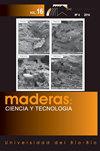Physical properties of palmyra palm wood for sustainable utilization as a structural material
IF 1.5
4区 农林科学
Q3 MATERIALS SCIENCE, PAPER & WOOD
引用次数: 0
Abstract
Physical properties are major characteristics that validate biomaterials’ adaptability to commercial utilization. The moisture content, density, swelling, and shrinkage within male and female Borassus aethiopum were assessed. Green and dry moisture content, and density were tested with the oven-dry method while swelling and shrinkage were evaluated using the water-saturation test and oven-dry methods respectively. Unlike moisture content, density decreased towards the crowns and radially from the peripheries to their cores. Directional swelling decreased as: Radial > Tangential > Longitudinal. Volumetric swelling was greatest at the core of the base (6,99 %) but at least at the periphery within the middle of the male (2,89 %). However, the female recorded much swelling at the core of its mid-portion (6,23 %) and least (4,01 %) at the crown periphery. Directional shrinkage decreased identically as the male variety while the volumetric shrinkage for both varieties was not consistent. The peripheries had less moisture content, better dimensional stability and density (which influences wood strength) at the butt than those of the core indicating the peripheries would maintain its original dimension and strength when subjected to environmental changes and be more viable for structural works than the core.棕榈木作为结构材料可持续利用的物理特性
物理性质是验证生物材料对商业应用适应性的主要特征。评估了雄性和雌性博拉苏内的水分含量、密度、膨胀和收缩。采用烘箱干燥法测定青坯含水率、干湿率和密度,采用饱和水试验和烘箱干燥法测定膨胀率和收缩率。与水分含量不同,密度沿树冠方向递减,沿周向核方向呈径向递减。方向肿胀减小为:径向>切向>纵向。底部核心部位体积肿胀最大(6.99%),但男性中部周边部位体积肿胀最少(2.89%)。然而,雌性在冠中部的核心部位肿胀较多(6.23%),冠周部位肿胀最少(4.01%)。方向收缩率下降幅度与雄品种相同,而体积收缩率下降幅度与雄品种不一致。与芯材相比,外围材在对接处的含水率更低,尺寸稳定性和密度(影响木材强度)更好,这表明外围材在经受环境变化时仍能保持其原有的尺寸和强度,并且比芯材更适合用于结构工程。
本文章由计算机程序翻译,如有差异,请以英文原文为准。
求助全文
约1分钟内获得全文
求助全文
来源期刊

Maderas-ciencia Y Tecnologia
工程技术-材料科学:纸与木材
CiteScore
2.60
自引率
13.30%
发文量
33
审稿时长
>12 weeks
期刊介绍:
Maderas-Cienc Tecnol publishes inedits and original research articles in Spanish and English. The contributions for their publication should be unpublished and the journal is reserved all the rights of reproduction of the content of the same ones. All the articles are subjected to evaluation to the Publishing Committee or external consultants. At least two reviewers under double blind system. Previous acceptance of the Publishing Committee, summaries of thesis of Magíster and Doctorate are also published, technical opinions, revision of books and reports of congresses, related with the Science and the Technology of the Wood. The journal have not articles processing and submission charges.
 求助内容:
求助内容: 应助结果提醒方式:
应助结果提醒方式:


